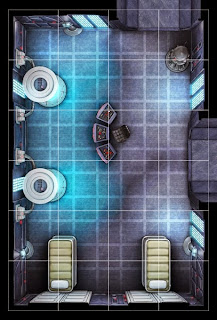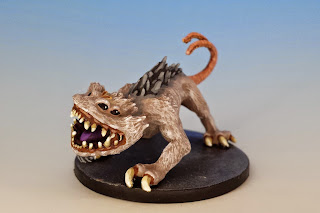If you've ever imagined what the opening scene of A New Hope would have been like if Darth Vader had boarded the Tantive IV ahead of the Storm Troopers, then Imperial Assault is the game for you.
And so, after writing a series of posts about the miniatures of Star Wars: Imperial Assault, it's time to take a look at game itself, and how the rules stack up against some of its competitors both ancient (Rogue Trader, Spacehulk) and modern (Saga, Bolt Action).
Imperial Assault is interesting in that it can be played in a campaign mode (in which 2 opposing players play through a scripted set of encounters with ever-improving characters); and in a skirmish mode (in which 2 opposing players play a one-off battle against each other using custom built armies). After playing both the campaign and the skirmishs, I've found that the skirmish mode is much more fun, so that's what I'll focus on for this review.
 |
| The Imperial Medical Bay Tile |
Customization is another element of Imperial Assault that I enjoy. You build your army by assembling miniatures (whose point cost and abilities are set out on illustrated "activation cards") -- and then you build a second deck of special abilities (called "command cards") that you will get to play against your opponent throughout the game. Such cards might let you heal, hide or activate a character's special powers. The synergies are endless. Yet it's an easy system without book-keeping or army lists. Altogether this system furnishes great scope for new strategies and to experimentation.
This customization gets at the heart of something that Fantasy Flight Games has made into an art form: creating a dead simple rule set, but adding thematic flavour and strategic complexity through cards, which bend or enhance the rules. So, for instance, all characters are capable of dealing critical hits (called "surges") but each character's surges have different effects -- and these effects are all set out clearly on their cards. This system adds depth without complexity. (The army lists of Bolt Action or the battle boards of Saga are other ways giving your army unique abilities, but I find that these mechanics can get convoluted and tie the players down to a rule book).
But my favourite thing about imperial Assault (besides STAR WARS) is the way they handle luck. Many (most?) skirmish games depend on a 6 sided dice (something that goes right back to Rogue Trader). The main advantages of 6 sided dice are that they're simple and everyone has some. But there are problems: the d6 creates a highly random system (since there is no curve, as you would get with rolling two 6-sided dice for a total between 2-12). Plus, even the smallest modifier (+1 or -1) changes the odds a great deal. The result is a game without much nuance, and where the players are dependent on luck to kill or preserve the most important models on the table.
Imperial Assault breaks out of this paradigm by using a simple solution: customized dice. The game features a variety of differently coloured 6-sided dice to determine attacks, each with its own combination of pips representing attack strength, range and critical hits. The pips are distributed in a way that softens the naked randomness of a roll between 1 and 6 (for instance, no attack die has a blank face, and no die has a face with more than three pips on it). As a result, while luck certainly plays a roll in the skirmish game, most attacks deal a fairly predictable amount of damage, giving the players more scope to focus on strategy and card-play.
What are the drawbacks to Imperial Assault? Well, certainly cost is one. The game itself is expensive ($99 USD), and the additional miniature packs are not cheap either, especially considering that the figures are neither resin nor metal. Also, the range of miniatures is limited. To date, there are only 22 different miniatures sculpts (with about 10 more sculpts in development). I hope Fantasy Flight picks up the pace -- but given their commitment to so many other games, it's unclear if this will happen.
A more significant problem flows from the game's very strengths. The dependence on miniature-specific cards means that your investment in the game could evapourate if and when Fantasy Flight Games decides to release a second edition with new rules. (Something like this happened when Imperial Assault's sibling game, Descent, transitioned from the first to the second edition. Fantasy Flight ameliorated the situation by releasing a "conversion pack" that issued new 2nd edition cards for the old 1st edition miniatures). This risk, of course, is not really a problem for historical wargames like Bolt Action or Saga, where an army of Saxons can always leap from one rule-set to another.
I've written about how we're living in a golden age of board games. I see Imperial Assault as part of that picture - a conscious effort to improve on old games using new and creative mechanics. Like Dead Man's Hand, it uses a deck of cards to enhance simple rules. Like Saga or Bolt Action, it uses customized dice. And like classic games like Heroquest or Space Hulk, it uses colour tiles to create a beautiful battle-board that anyone can access instantly, without a whole lot of modelling and set-up. And finally, like Warhammer 40K, it offers great possibilities for army building. But what Imperial Assault does that's unique is combining these elements into one cohesive game. Frankly, I can't wait to bust out Darth Vader and take another run at those Rebel Troopers...
 |
| My favourite activation card |



